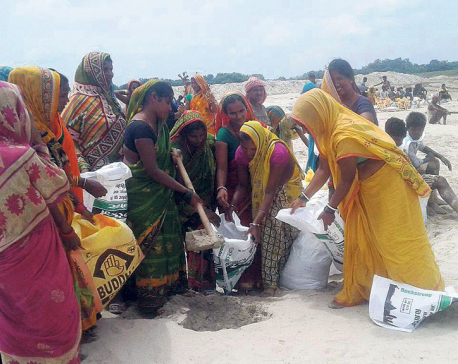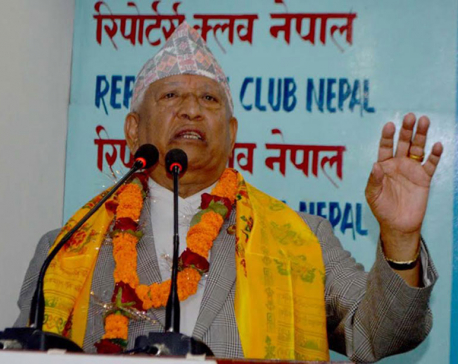
OR
Health Corner

What was once thought to be ailments of the elderly and old people, of late, seems to be quite common in young and adults alike. According to Dr Bimal Pandey, general secretary of Nepal Orthopedic Association and surgeon at Kathmandu Medical College, Vayodha Hospital, and Himal Hospital, people today have orthopedic problems regardless of their age and one has to know how to take care of their bones and muscles to keep them strong and thus prevent recurrent problems.
Here, Dr Pandey shares his expertise and tells us how we can take care of our bone health as well as arms us with information on what to do in case of injury.
The reason behind that back pain and its remedies
Of late, you will hear many people complain of backaches and muscle cramps. This is due to the kind of lifestyle they have these days, lack of exercise, and bad posture. Most of those with backache problems have quite sedentary lives. They drive, or take the bus instead of walking. There is limited and insufficient movement. This way, they are not exerting any pressure on their bones which would help in strengthening them. Also, people don’t pay attention to what they eat. They usually consume junk food and their diet isn’t rich in all the right nutrients either. Junk food and aerated drinks weaken bone density.
To stay fit and healthy, people shouldn’t stay behind the computer all day long even if they have desk jobs. I suggest they get up and walk around for a while every hour or so. People should also engage in some intense physical activity every single day. Human bones grow and build till the age of 20-25. So the more exercise and movement you provide them early on, the more benefits you will reap later in life. You also have to pay attention to your nutrition and make sure you are getting enough calcium and minerals as that helps in strengthening your bones.
Things to do if you are susceptible to backaches
If you are one of those people who are prone to backache, shoulder joints stiffness, and leg cramps when you are in your twenties and thirties, then chances are that your bones and muscles will progressively weaken leading to problems later on. To avoid such problems, you should give utmost priority to daily exercise. The only way to keep your muscles and bones strong is by making sure they are actively used.
If and when you suffer from severe pains, you can still exercise while lying down which will help ease the pain and effectively get rid of the problem for you. If you have an elderly member at home, encourage them to walk on plain surfaces even if they aren’t able to climb stairs. Any kind of movement is good for the joints and bones. For those who have severe knee joint pain, a walking stick can come in handy. But movement is a must.
First aid in case of injury
Fractures and dislocation of bones are emergency conditions that need to be treated as soon as possible so you should seek medical help immediately. When medical help is on its way, then attend to the injured person and try and manage the pain. While painkillers and icepacks can help on that front, you should also keep in mind that the injured person isn’t allowed to move. Then one can go about providing support to the wounded area by placing a solid cardboard or a wooden board underneath the affected area. Take care while doing this too. Don’t move the person but gently slide in the board. Also, tie a bandage loosely around the affected area. What you shouldn’t do at all costs is massage or apply heat on the affected area.
Dealing with fractures
It’s hard to recover from a fracture but taking care of simple things goes a long way in ensuring a speedy recovery. The bandage or the cast should be kept in a proper position. If the plaster needs the elbow to be bent or the legs to be upright then keeping them in that particular position and not applying too much pressure will help the fractured part heal effectively. The cast and the plaster shouldn’t be broken so be careful as you go about your daily routine. While showering, make sure water doesn’t enter the cast.
Keeping the affected limb in an elevated position helps reduce the swelling. As an entire joint or limb has to be immobile for a long period of time, the movement of fingers outside the cast and other parts of the body helps in reducing stiffness and allows proper blood circulation.
The post recovery period is important in making sure your fractured bones gain its initial strength. Physiotherapy is usually recommended for most patients of fracture but you can also do your part by engaging in light exercises on your own once the cast comes off. Gradually increasing the stress on the injured body part will help in strengthening the bones.
Things to do to strengthen your bones
Bones are quite literally the support system of the body, so it’s important to keep them strong and healthy. Here’s what you can do for that:
Reduce or eliminate sugar. Sugar robs your body of minerals, like calcium and magnesium, which are needed to build strong bones. You also need vitamin D as that helps body absorb the bone-boosting calcium. Boost vitamin D consumption by eating shrimp, fortified foods like cereal and orange juice, sardines, eggs (in the yolks) and tuna, or opt for a vitamin D supplement. For that, get your vitamin D levels checked and consult with your doctor who will be able to determine whether or not you need supplements based on the lab results.
Too much caffeine can interfere with the body’s ability to absorb calcium so if you love coffee, consider cutting down. Heavy consumption too can cause bone loss so it’s best to drink in moderation – one drink per day for women and two drinks per day for men. Many studies have shown that smoking can prevent the body from efficiently absorbing calcium, decreasing bone mass. So, if you smoke, it’s time to quit.
A sedentary lifestyle is considered a risk factor for osteoporosis. One study comparing bone density in college women with various body weights and activity levels found that athletes with low body weight had the highest bone density of any group in the study, showing exercise (and low body weight) can have a positive effect on bone density.
Weight-bearing exercises like running, walking, jumping rope, and stair climbing keep bones strongest. Resistance training has also been shown to improve bone health too, so pick up the weights after going for a jog. If you can’t squeeze in all that, walk for at least an hour every day as movement is essential for good bone health.
You May Like This

Flood-hit locals of Sakarpura building embankment
SAPTARI, August 20: Flood wreaked havoc in their settlement last Saturday. Life is yet to come to normalcy. In lack... Read More...

Minister KC stresses on following building code
BIRATANAGAR, Jan 15: Minister for Urban Development Arjun Narasingha KC has stressed on constructing quake-resistant buildings strictly abiding by the... Read More...

Newly-constructed school building provides relief to students
DOLKHA, July 28: Locals of Majhgaun-1 in Dolakha district have finally completed the reconstruction of quake-ravaged building of Majhgaun Lower... Read More...




Just In
- Kushal Dixit selected for London Marathon
- Nepal faces Hong Kong today for ACC Emerging Teams Asia Cup
- 286 new industries registered in Nepal in first nine months of current FY, attracting Rs 165 billion investment
- UML's National Convention Representatives Council meeting today
- Gandaki Province CM assigns ministerial portfolios to Hari Bahadur Chuman and Deepak Manange
- 352 climbers obtain permits to ascend Mount Everest this season
- 16 candidates shortlisted for CEO position at Nepal Tourism Board
- WB to take financial management lead for proposed Upper Arun Project






_20220508065243.jpg)








Leave A Comment